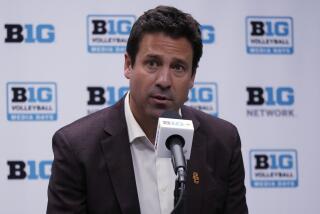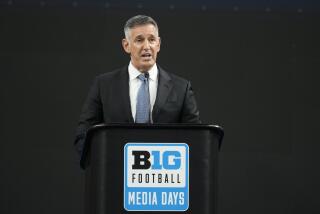Pac-10 was in a league of its own this spring and summer
The 2010 college football season — coming soon to a campus near you — faces the daunting challenge of getting the drama of its fall and winter to match its spring and summer.
The Pacific 10 Conference, of all the sleepy gym joints, caused most of the commotion by awakening from a publicity coma to make more headlines — good and bad — than it had in years.
In terms of noise levels, the league went from one kazoo to 50,000 vuvuzelas.
Led by its hotshot second-year commissioner, Larry Scott, the Pac-10 aggressively tried to become the Pac-16 and nearly knocked conference alignment off its Texas A&-axis.
The big-grab play for Texas didn’t work, ultimately saving the Big 12’s life, but Scott certainly got everyone’s attention.
Maybe he got played like a fiddle by Texas, only looking to hash out the best possible Big 12 deal for Texas (and getting it).
One insider with knowledge of the negotiations said there was never more than a “50-50” chance Texas was ever going to bolt.
“No,” Scott countered Thursday during Pac-10 media day at the Rose Bowl. “I believed they were absolutely sincere.”
Scott had a backup plan in case Texas didn’t come — and it’s going to be called the Pac-12, probably as soon as next year. Utah is already set to join in 2011, with Colorado probably coming on board a year earlier than planned because the Big 12 wants the Buffaloes and Nebraska out in the same calendar year.
In case you didn’t hear: Nebraska is joining the Big Ten in 2011.
After years as a contented, laid-back vacation destination, the Pac-10 is putting the “pro” back in proactive.
It unveiled its new logo last week — with a probable shelf life of only one year but the graphic designer standing by to change “10” to “12.”
How the conference splits into divisions is an issue Pac-10 athletic directors are going to have to hash out in the coming months. It may be a north-south divide or an east-west “zipper.”
Will the California schools still play each other every year?
“Not everyone is going to be happy, at the end of the day,” Washington State Athletic Director Bill Moos said.
While the Big Ten started Expansion Frenzy 2010 with its predatory exploratory notions, the Pac-10 ultimately stole the show — then took it to Broadway.
Scott, at great expense — $1 million? — hauled his entire coaching staff last week on a barnstorming tour of the East Coast, meeting bigwigs in New York and bigger wigs at ESPN who may have never heard of football out west.
The coaches visited the offices of the New York Times — which historically has found little Pac-10 news fit to print — and, on Wednesday, they and Scott rang the opening bell on Wall Street (the Dow Jones dropped 39.81 that day).
Then, it was a private charter flight back west (more $$$$), where the last tour leg ended with a final media glitz-blitz at the Rose Bowl, the coaches at one point being trotted down the stadium steps like the Mercury astronauts.
Thankfully, none of the coaches made reporters look at their New York vacation photos.
Cheesy?
“I didn’t hear any cynicism,” Scott said of the tour. “. . . This is the beginning of a different kind of approach.”
As splashes go, the Pac-10 made a cannonball into the deep end. It would have been bigger had the plan for 16 teams worked, but this seems like enough mix-it-up mayhem for now.
The Pac-10’s intentions have been stated and have reverberated.
The timing of the public relations junket was awkward in that it coincided with USC, the conference’s football face, recently getting hammered with NCAA sanctions that included scholarship losses and a two-year bowl ban (the school is appealing some of the penalties).
You know that old Hollywood adage, though, about there being no such thing as bad publicity. Besides, USC’s downfall could be the opportunity for other Pac-10 schools to garner some independent adulation.
Did you know, for instance, that Oregon, not USC, actually won the Pac-10 title last year and is picked to win it again this year?
This conference, whose headquarters are in the Bay Area (Walnut Creek) on several fault lines, is moving and shaking. There are plans for a Pac-10 TV network and notions of expanding the league’s broadcast reach to the Pacific Rim.
USC Coach Lane Kiffin, by himself, seems to be good for two or three national stories a week.
Of the past, Scott said, “There had been the feeling that the Pac-10 had been a follower.”
Not anymore.
The conference even raced to the forefront on correct conference membership counting, decisively declaring it will be called the Pac-12 once Utah and Colorado come aboard.
Elsewhere, with the loss of Colorado and Nebraska, the Big 12 will soon be reduced to 10 schools while the Big Ten, with the addition of Nebraska, will have 12 teams.
“I’m in communication with [Big Ten] Commissioner Jim Delany about a [name] swap,” Big 12 Commissioner Dan Beebe joked at his league’s recent media days.
The Pac-10 is no longer a punch line.
USC’s sanctions even advanced a national conversation about the insidious nature of agents.
The subject dominated recent Southeastern Conference media days after it was unearthed that unscrupulous agents might also a problem in other leagues.
Alabama Coach Nick Saban went so far as to compare agents to pimps, while SEC Commissioner Mike Slive sounded his own clarion call.
“This is a national problem that calls for a national strategy,” Slive said.
Anyone have one?
Brace yourselves, though, as this off-season may have been only a preview of coming expansion distractions.
“The music has stopped . . . for now,” said Scott, who still believes 16-school “super” conferences will someday dominate the landscape.
So, enjoy this, the last year of relative calm. Enjoy some alliances as we’ve known them.
Savor the last year of round-robin play in the Pac-10, Nebraska in the Big 12 for the last go-around and Boise State’s final year in the WAC before joining the Mountain West.
Are Texas and Nebraska playing each other for the last time this season?
After 2010, will Boise State ever play Idaho again?
This is the so-far year in which the Pac-10 took college football by surprise, easily winning the off-season BCS title.
Scott: “We kind of snuck up on people.”
More to Read
Go beyond the scoreboard
Get the latest on L.A.'s teams in the daily Sports Report newsletter.
You may occasionally receive promotional content from the Los Angeles Times.











